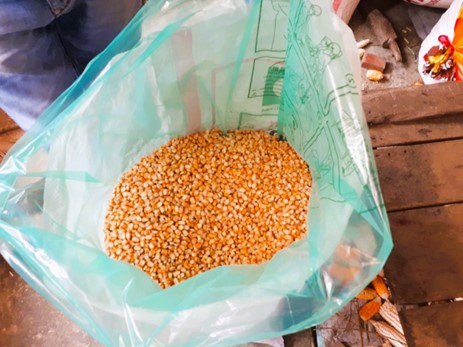The Economics of Reducing Food Losses: Findings from the ADMI Project in India
by Pallavi Shukla
Most scholars agree that reducing food losses is an important strategy for achieving a more sustainable and food secure future. Postharvest losses can account for a large share of total food losses, particularly in developing countries with inadequate public and private storage infrastructure. One of the goals of the ADMI project in India was to understand the extent of the problem and find cost-effective technological solutions to help smallholder farmers reduce postharvest losses.


Insect damage and physical grain losses in wheat during storage in Bihar, India
While previous research has studied the effectiveness of postharvest loss reduction technologies, the ADMI team found two issues that needed further investigation. First, anecdotal evidence from our field project in Bihar, India, suggested that the benefits of adopting postharvest loss-reduction technology were underestimated. This is because most research has focused on measuring the benefits of loss-reduction technologies on only some aspects of food security. Food security is a multidimensional measure, and evaluating the full impact of loss-reduction technologies requires measuring the effect of technology on each dimension of food security. So, the first goal of the ADMI research team was to estimate a comprehensive measure of the benefits of loss-reduction technology on all dimensions of food security. The second issue that the ADMI team noticed was that discussion about economic incentives for reducing postharvest losses is often missing from the debate on food loss reduction strategies. Few evaluations of loss-reduction technologies studied the economics of reducing food losses. The economics of reducing food losses include understanding returns to technology and a comprehensive economic cost-benefit analysis that accounts for quality, quantity, and financial losses in the absence of loss-reduction technologies. So, the second goal of the ADMI research team was to understand the economic benefits of adopting loss-reduction technologies.

The ADMI team provided access and training on the use of improved grain storage technology to over 3000 farmers in the state of Bihar in India. The ADMI research team used two randomized controlled trials – the gold standard in impact evaluation – to understand the full benefits of adopting improved grain technology on smallholder farm households. Our findings confirmed that past studies had indeed underestimated the wide-ranging benefits of postharvest loss-reduction technologies. The ADMI research team found that the farmers who used improved grain storage technology experienced nearly no physical grain losses due to fungal, rodent, or pest damage during storage. Using improved storage technology improved food safety by decreasing the incidence of aflatoxin contaminant – a potent, naturally occurring carcinogenic toxin in food – by around 75%. After harvest, farmers with access to improved storage were significantly more likely to store a larger share of their production (~ 20% more) for longer durations (~ 25% longer), helping them store for the upcoming lean season without worrying about spoilage. Improved storage also had a positive impact on grain marketability. Farmers who had improved storage technology experienced a 30% increase in the likelihood of selling grains in the market a few months after harvest, suggesting possible arbitrage. In other words, farmers who had improved storage did not sell all their grains immediately after harvest when market prices were the lowest but waited to sell later when prices increased, leading to higher farm profits. When farmers sell their grains immediately after harvest at low prices, they must buy back from the market later at higher prices for their consumption. The ADMI research team found that for the farmers who had improved storage technology, consumption of grains from their stocks increased by around 20%, and that from market sources decreased by 8%. This is an important cost-saving measure for low-income households that spend much of their income on food.
The ADMI research team also found that improved storage offered significant financial incentives for farmers to adopt the technology. Grain stored in improved storage preserved quality and received, on average, 13% higher prices in local markets than grain stored in traditional storage. Our benefit-to-cost analysis suggests that conservatively, farmers recovered the full unsubsidized cost of the (reusable) storage technology in one agricultural season. This research shows that previous evaluations of loss-reduction technology failed to capture over 60 to 70% of the benefits of technology. Thus, postharvest loss-reduction technology like improved storage reduced physical grain losses, preserved grain quality, increased storage duration and arbitrage potential for farmers, and consequently, increased farm household incomes. The use of improved storage also reduced the exposure of families to carcinogenic toxins, thus improving food safety and nutrition.
While many potentially beneficial postharvest loss-reduction technologies exist, they still need to be supported by large-scale public policies to promote adoption. One reason for the lack of policy support to promote loss-reduction technologies may be the need for more evidence on returns to adoption. The ADMI research team found that preventing food losses has both food security and economic benefits for smallholder farmers owing to quality, quantity, and income gains. These findings showed that local rural markets, even in poorer states in developing countries like India, offer economic incentives for preserving grain quality. Consequently, the benefits of adopting loss-reduction technologies like improved storage far outweigh its costs in this context.
Pallavi Shukla is a faculty member in the Department of Economics at Deakin University, Burwood, VIC 3125, Australia. Email: p.shukla@deakin.edu.au.
This research is published in the Journal of Food Policy. You can find the published version of the paper here.



1 Comment
Dear ShuklaI read your article. It is very interesting. I think it is hermetic storage system for grains. Earing is the second step of a farmer in the first step he needs initial financial support to purchase or invest. According to my knowledge the farming community of India and Pakistan have almost the same status of earning/profit. How much percent increase in the storage cost. I agree that there are premium benefits in terms of quality and quantity.
Add Comment